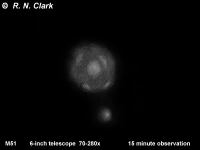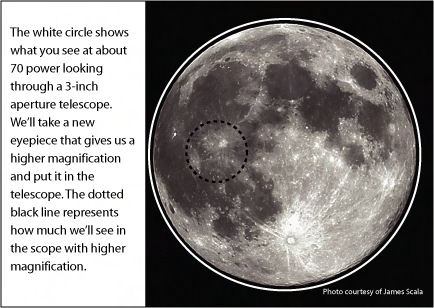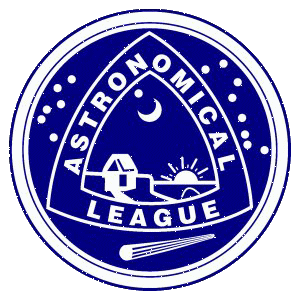


HOW WE & TELESCOPES SEE
OF TELESCOPE

|

|

|
HOW WE & TELESCOPES SEE |
| BACK | HOME | WHAT KIND OF TELESCOPE |
FIRST THINGS FIRST - BASIC OPTICSNone of this is necessary in order to simply look through a telescope, however you will need to understand this if you want to know enough to understand and expand on what visual astronomy is all about. The Human Eye The human eye is a wonderous thing. It allows us to see most of the things around us in what is called the visible spectrum of light. In order to understand telescopes, you must first understand how the human eye works. We must understand how we see, why we see what we see, and what we can do to see more. An advanced degree in optics is not required in understanding or buying a telescope, but the basics are needed in order to understand some important things regarding telescopes and their capabilities. This information will help to answer questions like, "Why doesn't it look like the color photos in books or on tv?", or "Why can't I see such and such deep sky object? It's on my chart, but I can't see it in my telescope." How We SeeEverything around us is seen as a result of light striking an object and then part of that light bouncing (or reflecting) into our eyes, through the lens in our eye, focusing the image onto the retina where its rods and cones are stimulated, sending signals to our brains which it then interprets and assembles those signals into pictures we recognize. This is Human Eyesight 101.  The cones contain receptors which are sensitive to one of three wavelengths of light : red, green, and blue, and allow resolution of fine detail . When these receptors are functioning correctly, we are able to see the full spectrum of colors by mixing these three fundamental colors together in our brains. The rods cannot distinguish colors and have poor resolution, but they have a much higher sensitivity to light than the cones. This is why in low light (e.g. under a full moon) everything looks like it is in fuzzy shades of grey. There isn't enough light to trigger the cones to detect color or fine detail. The Visible SpectrumThe color of an object is determined by which colors (wavelengths of electromagnetism) of the spectrum are absorbed by the object we are looking at, and which colors are reflected back. The colors absorbed are not seen by our eyes, the colors reflected back are what we see as the color of that object. A green blade of grass is seen as green because the wavelength of light being reflected back into our eye is the wavelength of the color green. All other wavelengths are being absorbed by the blade of grass.  White light is a combination of all of the colors of the visible spectrum. They can be broken apart into their individual wavelengths by passing the white light through a simple glass prism.  Pink Floyd fans will recognize this image. The Tiny Telescope In Your HeadYour eye is a simple telescope. It has a lens which focuses light to a point which can be seen and interpreted as an image by our brains. But it is a telescope with a VERY small "aperture" (light gathering opening), and therefore can gather a very limited amount of light from faint objects. Even though, unlike most telescopes, our eye can slightly change it's aperture to let in more light, it isn't enough to see very faint, dim objects.  The fainter an object, the larger the aperture that is needed to let in enough light to see (resolve) that image. Even with our pupils fully dialated (those who wear glasses and have been to an eye doctor know about pupil dilation), the human pupil can only get to about 7mm diameter (slightly bigger than 1/4 inch). Cats, which are renowned for their night vision, have the ability to expand their pupils to fill almost their entire eyes, thus giving them a wider aperture to gather more light onto their retinas, and see better in the dark. They have a bigger "eye-telescope" than we humans do. With telescopes (and pupils) bigger is definitely better in the dark.   Dark Adapted VisionWhen you turn the lights off at night, you are temporarily blind and cannot see anything except maybe the light coming from under your bedroom door. This is because your eye has not adapted (opened) to the darker situation. Your iris (the colored part of the eye - this is what opens and closes the pupil diameter) does not react to light changes immediately, it takes a second or two to react. It will quickly open to an "emergency" adjusted size to compensate for the sudden change in lighting. But this is not a fully dark adapated eye. The rods take a few minutes to fully begin to register the visual images in lower light. They take a little while to "warm up".  Iris opening/closing in real time. (note: Not instantaneous) Your eye will do this in bright light as well by closing the iris to let less light in so you don't permanently damage your retina. This is why you should NEVER look directly at the sun! You will damage your eyesight, possibly for forever!! In extreme darkness, over a period of 30 to 45 minutes your iris will open up even more and your rods will begin to respond to the dark more. This is called "dark adaptation". This is why after a few minutes in the dark, you begin to see more and more objects around you in the dark as time goes on. Your pupil is quickly stretching open to its widest possible "aperture" to let in the maximum amount of light. And then after several minutes the rods in the back of your eye all start to fire and send signals to your brain. Starlight, Starbright, What We See At Night Light is made of particles called photons. Photons radiate out from, or is reflected off, a celestial object in all directions (360 degrees) unless something is blocking it. As the light moves away from the object the photons spread out in straight lines to one another. as they get further and further apart (i.e. further from their source), we see this as the light getting dimmer and dimmer. They actually follow a mathematical rule that says every time you double the distance from the source, you reduce the brightness by four times. This is because you have the same number of photons spreading out over a larger and larger area as it moved away form the source. In the diagram above the lines represent photon paths. All of the squares are the same size. In the first square (r) all of the photons are passing through that one square, so the image would be bright. In the next block (2r) the light has spread out and now the same number of photons fit into four squares instead of just one, so the light is four times dimmer. In the next block (3r) the photons are passing through nine squares, and still dimmer yet. This continues until the photon is reflected (planet, mirror, etc) or absorbed (nebula, dust, your eye) by another object. When the photons travel far enough away from their source they appear essentially to be traveling parallel to one another by the time they finally reach your eye. Fainter objects have fewer photons reaching your eye per square inch. The parallel "lines" of photons coming from most celestial objects are so spread out, not even our dark-adapted, naked eyes can see them. The human eye is just not big enough to catch enough photons to trigger our rods or cones (vision nerves) in our eyes. Some instrument is needed to gather more light than our human eye is capable of gathering, and to project it into our eyes to see. This is what telescopes do. Telescopes don't really magnify an image so much. What they really are best at is amplifying the light from very faint objects!  A telescope is used to gather more light than the human eye is capable of gathering on its own, and focusing that larger amount of light to a size small enough to fit through the pupil opening of our eye. The larger the telescope, the more "parallel lines of photons" are captured, the more light gets to our eyes, and the image is brighter and shows more details.  "Resolution" vs. "Magnification"MAGNIFICATION - or as is shown on cheaper telescopes, "power" - is determined by the eyepiece used, not by the size of the telescope. RESOLUTION – or how much detail you can see – depends primarily on the aperture of the telescope (assuming the equal quality of the primary lens or mirror). Higher magnification might make it easier for your eye to perceive the detail the telescope is capable of giving you, but the telescope cannot collect any more detail (in other words, get better resolution) with higher magnifications. The images below are all of the same celestial object, The Whirlpool Galaxy also known as M51. The first image was taken with a 6-inch diameter (aperture) telescope, the second image was with an 8-inch diameter telescope, and the third image was taken with a 12-inch diameter telescope. The difference is obvious. You're not seeing more magnification in each image, you're seeing more resolution due to the successively larger diameter mirror system used. APERTURE RULES in astronomy!    Just as reading glasses compensate for our eye's lens being insufficient to focus an image correctly onto our retina to see clearly, telescopes compensate for our relatively small pupil opening by augmenting that opening and making it artificially larger. Another example: 
Although other telescope characteristics, like magnification, are sometimes referred to as the telescope’s power, the “power” of the telescope is not how much the image is magnified. The real "power" (usefullness) of the telescope comes from the size of its primary lens or mirror - how big around the telescope is. So when you go to buy a telescope, pay more attention to the diameter, or aperture, of the telescope and the quality of the mirror or lens, not the claimed magnification. Larger diameter telescopes collect more light from the object you are viewing. The diameter, or aperture, of the telescope is one of the primary factors that determines how bright the image is and how much detail you will see when you use an eyepiece to magnify the view. You can always buy more eyepieces for more magnification after you have bought your telescope. But once you buy a telescope, you are stuck at that scope's resolution level for the duration of owning it. What Happened To All The Color? Most of the astronomy pictures you see in magazines are in color so it might be disappointing not to see any color in the telescope. As mentioned above in our discussion of the human eye, our eyes cannot detect much color in dim light. So when we look through the scope, for the most part our eyes only see shades of gray.
White light, like a full moon or white flashlights, in a way washes away the chemical and makes us blind to dim objects until our eyes once again adjust. That’s why we want to use low-energy red flashlights to minimize loss of our night vision so we can more easily see the detail of the universe as revealed in the telescopes. ConclusionUnderstanding how our eye sees in the dark, and what the telescope is doing, will help in understanding why telescope size is so important as opposed to "power". In the following section you will find out what the different types of telescopes there are, and with your understanding of basic optics, why each type of telescope is designed the way it is. This information my help you if you are in the market to buy a telescope. |
 |
Send emails to: webmaster@fortworthastro.com |
FWAS is a member of the Astronomical League. The world's largest federation of amateur astronomers. |
 |